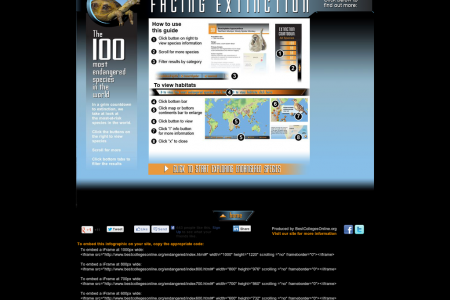
Endangered species: Going, going, gone
Endangered species: Going, going, gone From March 3-14, members from 177 governments will gather in Bangkok, Thailand, for the sixteenth meeting of the Conference of the Parties in CITES (Convention on International Trade in Endangered Species of Wild Fauna and Flora). CITES aims to ensure that international trade in specimens of wild animals and plants does not threaten their survival. Roughly 5,000 species of animals and 29,000 species of plants are currently protected against over-exploitation. Since the convention was opened in 1973, the number of CITES member states has steadily increased and will total 177 once the Maldives joins on March 12 this year. CITES Conference of the Parties 1976 Bern, Switzerland 1979 San José, Costa Rica 2007 1981 New Delhi, India 1987 1976 1989 1983 Gaborone, Botswana 1992 1985 Buenos Aires, Argentina 1981 1994 2010 1987 Ottawa, Canada 1989 Lausanne, Switzerland 2004/2013 1979 1992 Kyoto, Japan 1994 Fort Lauderdale, US 2000 1997 Harare, Zimbabwe 2000 Gigiri, Kenya 1997 2002 Santiago, Chile 2004 Bangkok, Thailand 2002 1985 1983 2007 The Hague, Netherlands 2010 Doha, Qatar 2013 Bangkok, Thailand CITES members Year 1980 1990 2000 2013 180 160 140 120 100 80 60 40 For sale: Wildlife, fish and timber In Bangkok, CITES will consider 70 proposals to increase or decrease controls on this type of trade, submitted by 55 member states. The proposals affect some 320 species, including the polar bear, African elephant, white rhinoceros, turtles, frogs, crocodiles, several shark species, the manta ray and tropical timbers. It is difficult to estimate value of the illicit wildlife trade since it is illegal but the World Wide Fund for Nature report issued in December 2012 had the following estimates: $Billion per year Fish: $6.9* $22.8 Timber $7 billion Other wildlife: $8.9* Combined Together that means the illegal trafficking of wildlife, timber and fish is the world's fourth biggest illegal trade after drugs, counterfeit products and people. Drugs: $320 billion Counterfeiting: $250 billion Humans: $31.6 billion Wildlife, Timber & Fish: $22.8 billion Oil: $10.8 billion Art & Cultural Property: $4.9 billion Gold: $2.3 billion Human Organs: $0.91 billion Diamonds & Colored Gemstones: $0.86 billion * When a range of estimates are reported the mean value used. Trade routes The WWF estimates 100 million tonnes of fish, 1.5 million live birds and 440,000 tons of medicinal plants are traded illegally every year with China- the largest market for such activities, followed by the US. Illegally trafficked animals in Asia usually end up as food or medicine. In the US and Europe they are commonly sold as exotic pets. A range of other consumer products are sold across all regions. There are a number of illegal trade “hotspots", including China's international borders, East/Southern Africa, the eastern borders of the European Union, some markets in Mexico, parts of the Caribbean, New Guinea and the Solomon Islands. Southeast Asia is becoming another major area of concern, functioning as a trade hub between other major markets, including China, India and Indonesia. The illegal trade of wildlife and timber is thought to be worth up to $10 billion in this region alone, some of the major wildlife and timber trade links in this area are highlighted below. Europe Japan China India Myanmar Central Africa Southeast Asia Southern Africa Wildlife trade routes Timber trade routes The Association of Southeast Asian Nations' Wildlife Enforcement Network (ASEAN-WEN) was launched at the end of 2005 to help combat such illegal activity in this region. Nonetheless, wildlife trade is generally not taken as seriously by governments as trafficking in other goods, and for traffickers it is still often considered as "Low risk, high reward". Black market commodities WWF believes that up to 30,000 African elephants are slaughtered each year due to the illegal ivory trade, roughly six percent of all specimens alive today. Their population has halved since 1979 and if current trends continue they could disappear from the wild entirely in just a few decades. Conservation status, population, and the approximate retail value for selected protected species are shown below, although given the illegal nature of the trade these are only estimates: Near threatened Vulnerable Endangered Critically endangered Southern African Polar Bear Ploughshare Tortoise Thailand Tiger Black Burmese White Rhino Elephant Rosewood Panthera Tigris Ursus Rhino Star Tortoise Maritimus Ceratotherium Simum Simum Loxodonta Africana Dalbergia Cochinchinensis Geochelone Platynota Diceros Astrochelys (Geochelone) Yniphora Bicomis Estimated remaining population 20,170 513,620* 90,000* 22,500 3,000 4,810 400 "Very small" Estimated retail value $60,000 $1,200 Up to $6,000 $15,800 $35,000 $60,000 Up to $250,00O $1,500 per kg of rhino horn per kg of ivory per cubic metre per pelt per pelt per kg of rhino horn per tortoise per tortoise The ploughshare tortoise population is thought to have fallen from 800 in 2005 to around 400 today, of which only 200 are adults. It takes these tortoises 20 years to reach sexual maturity and the species is at great risk of extinction in the next 10 to 15 years. A single, large female was recently seen on sale in Indonesia for $250,000. *When a range of estimates are reported the mean value is used. All values are estimates. Ilustrations not shown to scale. Sources: CITES introduction http://www.cites.org/eng/disc/parties/index.php For sale: Wildlife, fish and timber http://www.cites.org/common/news/2012/Dalberg-Report-on-Fighting-Illicit-Wildlife-Trafficking.pdf http://transcrime.gfintegrity.org/ Trade routes http://www.cites.org/common/news/2012/Dalberg-Report-on-Fighting-Illicit-Wildlife-Trafficking.pdf http://www.brookings.edu/research/papers/2011/06/illegal-wildlife-trade-felbabbrown Black market commodities http://www.wwf.org.uk/news_feed.cfm?6484/ivory-emergency-CITES-could-penalise-countries-who-dont-tackle-illegal-trade http://www.newson6.com/story/21191082/3-charged-in-smuggling-horns-of-endangered-rhinos http://www.eia-international.org/wp-content/uploads/Rosewood-Robbery.pdf http://www.guardian.co.uk/environment/2012/oct/01/polar-bear-legal-trade-ban?INTCMP=SRCH http://www.iucnredlist.org/details/9016/0 ALJAZEERA
Endangered species: Going, going, gone
Source
http://www.a...15373.htmlCategory
AnimalsGet a Quote









